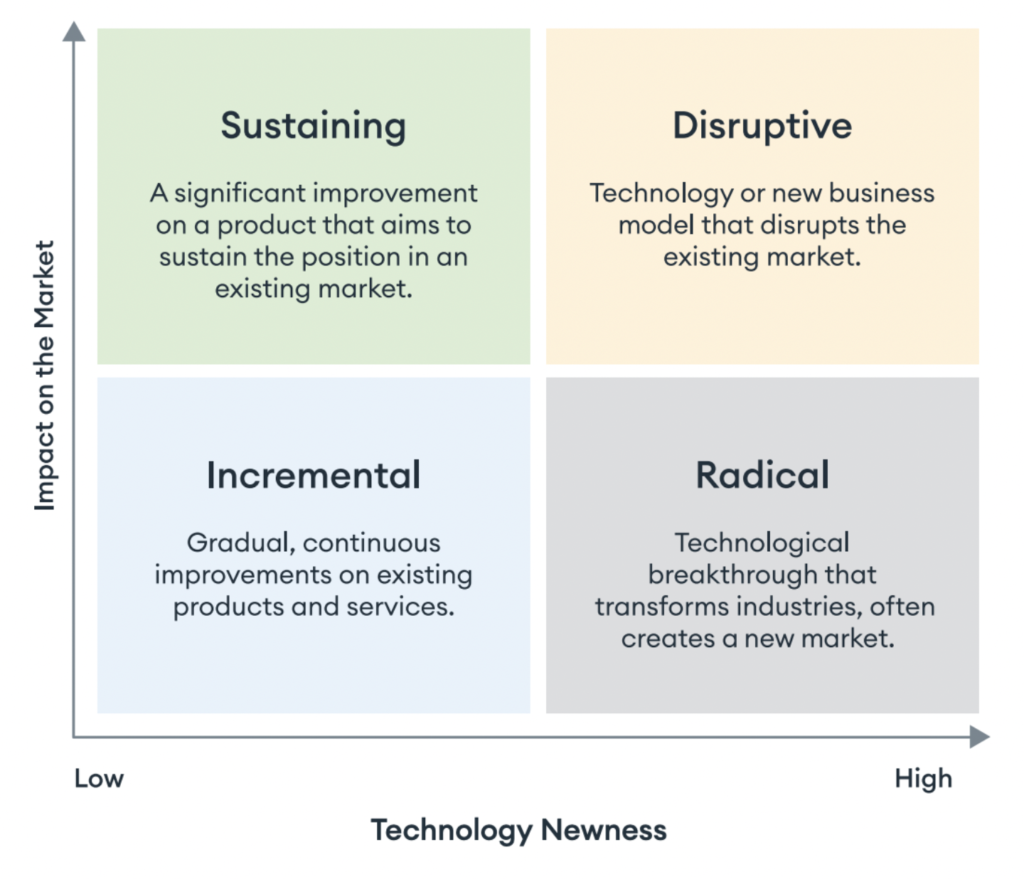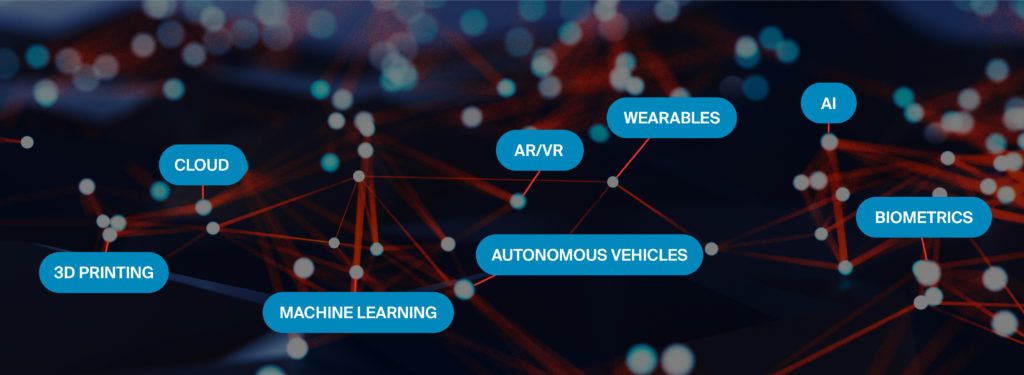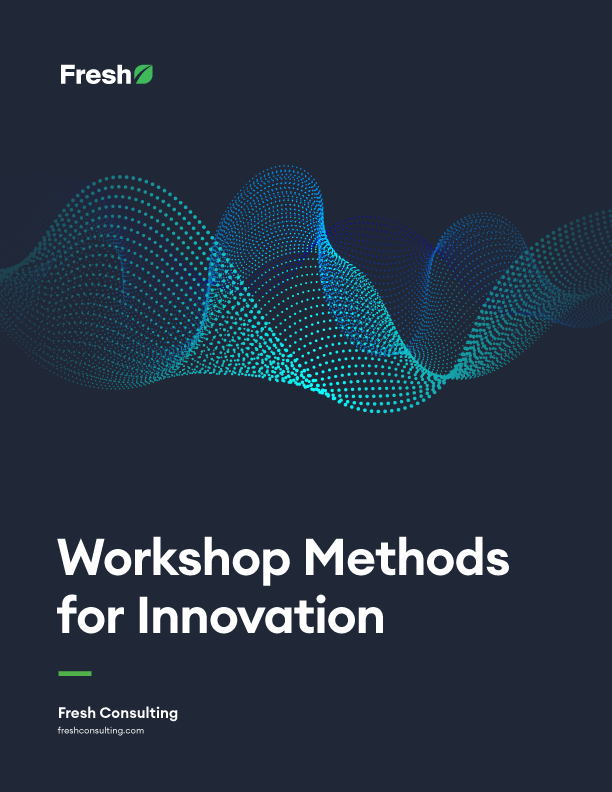Article
Digital Transformation Strategy: An Actionable Roadmap

Digital transformation strategy across industries
If you Google “digital transformation,” you’ll find a definition in the sidebar: “the adoption of digital technology by an organization to digitize non-digital products, services, or operations.” What a mouthful! Let’s keep it simple, in our effort to accurately explore the what and why of digital transformation strategy.
Digital transformation is:
- Integrating “digital technology”
- (cloud-based apps, robots, AI, etc.)
- Into various areas of a business
- To create new products, processes, and workflows
- Or optimize existing ones.
The outcome? Changing how your company operates and delivers value to customers.
On our digital transformation service page, we elaborate on why digital transformation matters upfront:
In the increasingly competitive global economy, companies rise quickly and engulf entire businesses, and incumbents are disrupted in the blink of an eye. Businesses must continuously seek to achieve digital transformation to stay on the leading edge.
So where does digital transformation strategy fit in? Why not just find what’s working for your competitors or industry leaders and use it for your business?
The answer is simple: change happens fast. Instead of being reactive and applying a short-term salve, your business should be proactive and prepared for ongoing transformation. Future-proofing your processes and workflows for the lightspeed pace of innovation requires having an actionable plan in place.
The ultimate output of digital transformation may be adopting new technologies, but we argue that it starts with creating a culture of innovation. Doing so is the most reliable way to capture hearts and minds and onboard your organization to a novel way of doing business.
If being better positioned to grow, scale, and adapt to the ongoing evolution of our Digital Age is something your business needs, digital transformation strategy is worth considering. Fresh can help you create and implement a strategy customized to your unique requirements.
In this blog post, we’ll discuss:
- Which industries can benefit
- A deep dive into the elements of digital transformation
- The four primary types of innovation and how to foster a culture open to change
- The essential role that automation will play and how to alleviate fears about it
- Tips for getting started today
Without further ado, let’s dive in!

Four industries that stand to benefit from further digital transformation
Ports
The complex nature of modern trade necessitates digital transformation. To handle increased traffic, future-ready ports will explore how to automate traditional workflows and increase port connectivity. Other digital transformation use cases, among the many available for ports to consider, include:
- Incorporating cloud-based platforms.
- Leveraging predictive analytics.
- Maximizing cybersecurity infrastructure
- Using digital twins for proactive equipment maintenance
For more information on our approach to working with ports and in the logistics sector, consider exploring the following posts:
- Ports of the Future: Three Examples of Global Leaders
- A Fresh perspective on driving port innovation & solutions
Healthcare
Hospitals, healthcare providers, and medical technology companies are already immersed in digital transformation initiatives. The complexity of modern medicine will require further progress, with efforts including:
- Accessible, error-free, secure Electronic Health Records (EHRs)
- More sophisticated, high-tech telemedicine options for patients
- Remote monitoring, enabled via data telemetry, to create better insights about patients for their providers
- AI and machine learning to diagnose, predict, optimize, and personalize various facets of healthcare and medical research
For more information on our healthcare and medical device development workflows, these posts provide an informative overview:
- Perspectives on the future of healthcare
- Medical Device Development: The “It’s Just Software” Myth, Debunked
- Medical Device Software: Strategies for Seamless Development
- Medical Device Engineering and Cross-Disciplinary Collaboration
Manufacturing
Digital transformation in the manufacturing industry is well underway, but organizations at the cutting edge will consider additional opportunities for:
- Digital tools for real-time supply chain and inventory management
- Robotics and automation systems to streamline repetitive tasks, increase production, and ensure a consistent, high-quality output
- Smart manufacturing through the integration of IoT devices, sensors, and advanced analytics
- Virtual Reality (VR) and Augmented Reality (AR) to aid in training, system and design visualization, and remote troubleshooting or operator assistance
Interested in learning more about Fresh’s approach to manufacturing automation? Consider checking out these thought leadership pieces:
- Manufacturing Automation Systems: When and What to Automate
- The Ongoing Evolution of Industrial Automation
Financial and FinTech
With its data-driven nature and demand for high-quality customer service, finance and FinTech can benefit significantly from embracing digital transformation opportunities, including:
- Advanced chatbots and AI-driven customer support to ensure high-quality, 24-7 service
- Real-time fraud detection via advanced analytics and machine learning algorithms to detect anomalies, unusual patterns, and unwanted transactions
- Digitally personalized services that leverage data analytics to tailor products for individual customers’ needs and preferences
- RegTech (regulatory technology) to help financial institutions comply with complex regulations more efficiently
If you’d like to learn more about Fresh’s approach to the financial industry and our perspective on fintech, consider reading these articles:
- The Power of Artificial Intelligence in Fintech
- Open Banking Opportunities for Innovation
- Smart Branch Strategy and Enhanced Customer Experience in Banking
- Branch Transformation: A Primer for Modern Banks
Digital transformation strategy: a game plan, a blueprint, a set of tactics
Choose any of the labels above––that’s why strategy matters. Strategy, at its core, is:
- Established: A well-documented, agreed-upon vision for navigating uncertainty, building consensus, and guiding change
- Actionable: A method (or methods) to move your vision forward and achieve long-term goals, with concrete steps and milestones along the way
But for many, the status quo feels safe. The outcome of change––despite our best efforts to predict exactly what will happen––is uncertain. So why worry about the leading edge when an existing approach has worked and proven its value?
In sum, how do you convince people on the fence that something like “digital transformation” is worth investing in?
At Fresh, we often say, “what got you to today won’t necessarily get you to tomorrow.”
Regardless of whether the change you initiate is drastic or incremental, we don’t recommend throwing the baby out with the bathwater. In other words, don’t discard what works and what brings value (elements of your existing approach) along with what has become messy, obsolete, and/or inessential. But be aware that although innovation carries risk (throwing out the bathwater at all requires decision-makers to embrace change and an inherent degree of uncertainty) there’s a risk to not innovating as well.
With an established, actionable digital transformation roadmap in place, you can achieve “parity plus”––a way of doing business that’s equal to AND greater than the processes, workflows, and systems you already have in place. In most cases, you can leverage what you have in place and build on it. Digital transformation doesn’t necessarily require starting from scratch.
A few upfront strategic considerations can add additional clarity about the impact of change. When making transformational business decisions, decision-makers should:
- Consider the impact. What ripple effect will changes have on organizational KPIs (key performance indicators)? Address concerns––and proposed solutions––from the outset.
- Consider the cost. How expensive is change? Will adjustments to the technology you use and how you do work have repercussions for efficiency, resourcing, and revenue? These concerns are valid and should be addressed.
- Consider the feasibility. Do you have the foundation in place to initiate change and sustain a new approach? Do you have systems available to gather data and insights in real time? How will you measure progress and ROI?
Sometimes businesses aren’t ready to make significant organizational shifts––that’s okay. Starting with less is a viable strategy, too, one we often recommend.
But in our increasingly competitive global economy, the simple truth is this: proactive digital transformation strategy is crucial because change is inevitable. Concerns about the risk of transformation are justified, but there are practical approaches to alleviating them and building trust.
Digital transformation planning is your game plan, your blueprint, your set of tactics. It considers the impact, cost, and feasibility of optimizing existing processes and/or implementing larger changes. With an established vision and an actionable approach, your team can build consensus and identify a practical path forward.

A note on “creating a culture of innovation” for digital transformation strategy
Whether you’re seeking to transform your processes (process transformation), your business model (business model transformation), or extend your products, services, and offerings (domain transformation), our experience has shown that true, lasting transformation begins with cultural transformation.
Creating an organizational culture of innovation that’s open to digital transformation requires understanding where your company already lies on the innovation spectrum. In our white paper on Creating a Culture of Innovation, we discuss the four primary types of innovation. Before we explain how this will affect your strategy for digital transformation, let’s discuss the x and y axes:
- “Technology newness” describes whether a specific innovation is based on emerging or well-proven technologies
- Low market impact ideas are often easier to implement and typically carry compounding effects over time
- High market impact ideas tend to be more difficult, costly, and risky to develop but arrive with higher potential value from the outset

Disruptive Innovation: Higher impact, higher novelty
Disruptive innovation involves adopting, using, or creating new technology, often with high-impact results. Startups typically fall in the “disruptive innovation” category, as they target overlooked segments in the market to deliver an alternative product, model, or approach, as do highly innovative companies that consistently seek to “disrupt” the status quo.
Referring back to our digital transformation services page, we state that in the modern business landscape, “incumbents are disrupted in the blink of an eye.” That’s what we’re referring to here––the disruptors themselves and the organizations open to adopting their cutting-edge technology.
This can pertain to:
- Internal processes and workflows: Tool adoption, e.g. becoming early adopters of the most cutting-edge platform on the market and accepting the risk that comes with that decision
- Your company’s output: Creating something entirely new or pivoting your current offering (your domain) in a drastic, disruptive way.
Think:
- Amazon > Amazon Prime > AWS
- Microsoft > PCs > Gaming > Azure
- 3D Systems > Industrial Stereolithography > At-Home 3D printing
But for every Amazon, Microsoft, or 3D Systems, there are another dozen companies that haven’t had the same success in shifting domains. Disruptive innovation is a high risk-high reward approach, but it’s essential in a competitive landscape, especially for the companies that have the means to pull it off successfully or those that are daring enough to blaze new trails.
Incremental Innovation: Lower impact, lower novelty
Incremental innovation constitutes a gradual improvement of existing products, services, and workflows. While it might feel like the least flashy of the four categories, incremental innovation still has the potential to deliver massive results. Organizations can maintain relevance, decrease stagnation, and consistently grow market share by continuously improving products, services, and workflows.
With regard to digital transformation, this can pertain to:
- Internal processes and workflows: Adjusting your company’s approach to work more conservatively, over an extended period of time, with carefully measured cycles of adoption, analysis, and iteration
- Your company’s output: Pivoting slightly by offering your solution to a new market, or implementing a new feature set based on well-documented insights about your customer base
Sustaining Innovation: Higher impact, lower novelty
Sustaining innovation is a great way to protect an organization’s position in a market. Where incremental innovation focuses on small improvements to existing products, services, and workflows to increase value, sustaining innovation focuses on larger, longer-term initiatives to gain or maintain market-leader position.
With regard to digital transformation, this can pertain to:
- Internal processes and workflows: A large shift––e.g. a new sales model, supported by adopting a new platform––with aggressive milestones while still being rolled out in a sustainable, maintainable way
- Your company’s output: R&D efforts aligned with a long-term game plan, while maintaining the core of what has worked for your business historically
Radical Innovation: Lower market impact, higher technology novelty
Radical innovation “is an invention or change that has not been seen before, [one that] destroys or supplants an existing business model [ . . . ] and replaces it with something entirely new.” This is throwing the baby out with the bathwater––going all-in on a technology breakthrough that has the potential to transform industries and create new markets. But the success of the underlying technological shift to drive this type of innovation depends on the right conditions.
Blockchain was introduced in 2008 as “a proposal for bitcoin, a virtual currency system that eschewed a central authority for issuing currency, transferring ownership, and confirming transactions.” Whether blockchain was released in response to the 2008 financial crisis or the fundamental issue of financial sovereignty, its purpose was to decentralize ownership and authentication.
This is a good example of radical innovation. Blockchain is still relevant, still in play, but its role in recreating a recent financial crisis––the kind it was designed to prevent––is difficult to ignore. Radical innovation carries a substantial degree of risk and uncertainty.
What about the “radical” designation, though? Doesn’t that imply something drastic and far-reaching? Why would radical innovation have a lower market impact?
Despite the Fortune Favors the Brave! advertisement starring Matt Damon, cryptocurrency still isn’t mainstream, though it does have a robust community of enthusiastic adopters. It’s still potentially drastic and far-reaching, but at the moment, cryptocurrency hasn’t replaced traditional finance.
Blockchain extends beyond cryptocurrency, however. Though the metaverse is still in its infancy, the future of the metaverse is so bright that we’ve partnered with Peer Inc. to bring the AR metaverse to market. As it comes to fruition, the metaverse will involve blockchain technology and constitute a groundbreaking shift in the way we access the internet and connect with each other.
Despite substantial investments in new technologies, the market hasn’t completely shifted yet. But we believe in the potential of the shift, of the potential for something radical to transition into a more disruptive state, then, ideally, an incremental and sustaining form of innovation.
The gist of radical innovation is that it’s localized and niche. A quantum leap in the medical industry likely won’t affect the entertainment industry, at least not directly. A revolutionary approach to manufacturing might not impact the hospitality industry unless they’re utilizing the goods being produced. Cryptocurrency is popular with believers in its potential, but traditional, centralized banks still exist, as does Web2 despite the coming arrival of Web3.
Tying this back to digital transformation, radical innovation can pertain to:
- Internal processes and workflows: A niche, localized solution that has major implications for an organization in a specific industry. The solution might even be customized based on their unique needs but still carry the risk associated with a major paradigm shift of replacing something existing with something brand new.
- Your company’s output: Taking the medical industry example mentioned above, a radical innovation could have the potential to change the way surgery is performed but carry financial risk for early adopters.
Four types of innovation––where does your company fit?
The point is that digital transformation is not one-size-fits-all. It looks different for companies in different industries. Even if two companies are in the same industry and provide similar goods and services, they’ll inevitably have unique strengths, weaknesses, and areas of opportunity, hence the importance of a customized strategy.
By fostering a culture of innovation organization-wide––then considering process transformation, business model transformation, and domain transformation––your company will be better primed for change.
- Are you a disruptor? Are you open to the solutions created by disruptors? That will likely impact the aggressiveness of your strategy for digital transformation.
- Are you an established brand name? Incremental or sustaining innovation might be more appropriate for your customer base.
- Does your organization live on the cutting edge? Radical innovation is a possibility, but one that carries substantial risk.
Depending on how innovative your company currently and how innovative you are open to being in the future, the elements of your strategy for digital transformation will change.

A note on the role of automation in digital transformation
In the 1990s, the standard way of connecting to the internet was through slow, cumbersome dial-up connections. Now, thanks to advances in firmware engineering and other technologies, we embed wireless internet into all kinds of everyday objects.
Our living and working environments have become an Internet of things (IoT)––connected devices capable of “talking to each other,” no dial-up connection required.
This shift opens up new possibilities for automating traditionally manual processes and workflows. Advancements in artificial intelligence, machine learning, voice AI, cloud computing, and autonomous systems stand to accelerate the transition. But the shift to more automation brings justifiable anxiety for many about being replaced in their jobs and/or having their roles reduced.
Fresh’s Automation Director Marco Micheletti, spoke about the fears associated with automation in a recent podcast episode:
“People think of automation as the opposite of people or exclusive of people, but I really think the approach and the mindset is that it’s about people, actually. Automation is about people using robots. It’s about how we bring people along, include them in the process, and help them understand that this is for their benefit.”
Let’s take a slightly wider view of traditional “robots” to include things like robotic process automation (RPA), automated enterprise platforms, and other examples of how AI/ML are providing the possibility of automation across a range of industries.
Marco’s point still holds true:
Digital technologies that enable automation are not a replacement for humans; they’re tools that empower us to do better, more fulfilling, more productive work.
Automation in e-commerce could involve an RPA solution integrated into a payment system to decrease manual data entry, reduce inefficiencies in a workflow, and boost productivity. That’s an example of automation and digital transformation. Integrating “digital technology” (AI/RPA) into a traditionally manual process could free up a swamped team to focus on exceptional customer experience instead of busy work. Even if it’s a fairly simple example of digital transformation, it has the potential to move the needle in a significant way.
Let’s circle back to automation:
- The internet is different now than it was in the early 90s
- The way we do work is also different––in certain fields, much less manual––thanks in large part to the internet’s evolution
- The shift has involved the adoption of new technologies (albeit technologies that are becoming less novel and more mainstream as time passes)
- This has allowed organizations to digitally transform, creating new products, processes, and workflows and/or optimizing existing ones
The shift toward more automation doesn’t just affect a company’s financial bottom line. It also has major implications for employee engagement, customer satisfaction, brand perception, and much more.
The best way to alleviate fear about displacement is to communicate the value of automation and your company’s stance on it. Advanced forms of digital transformation will involve more automation, but as Marco said, it’s ultimately about people––empowering them to do better, more fulfilling work––rather than being exclusive.

Getting started with a digital transformation
We’ve covered why strategic digital transformation is important, how to assess the state of your company’s current culture of innovation, and the role automation will inevitably play in advanced forms of digital transformation.
Let’s get into the “how” of digital transformation strategy and how you can get started today by:
- Setting up agile processes
- Prioritizing customers
- Leveraging the structures and systems you already have in place
Plan for agility at a scale with innovations sprints
The most successful innovative businesses are agile and quick to adapt to change. A digital transformation strategy is established, documented, and agreed upon. But it shouldn’t be static, and room should be reserved for adjustments and pivots.
One way we approach this challenge at Fresh is through innovation sprints, a workshop process to:
- Bring together stakeholders and team members to create a shared vision and direction
- Assess progress at a weekly interval instead of monthly or yearly
- Gather feedback from users and stakeholders to validate thinking
- Gain insights, ideas, and direction to move forward
Fresh’s experts guide your team in paving the way to new ideas, prototyping solutions, and testing them with users (this could include employees or customers, depending on the solution in question).
An agile, flexible approach is essential for an effective digital transformation strategy. As digital transformation scales at your organization, this is especially true in accounting for changes in the technology or industry landscape.
Understand the impact of change on customer experience
If you have an established business, you provide goods and services to an existing customer base. Digital transformation strategy can be a competitive advantage in maintaining your relationship, but it’s also essential to understand how changes (even to an internal process or workflow) will affect the customer experience.
By incorporating the principles of human-centered design into your strategy, you can:
- Focus on people––and design new products, services, and human-centric workflows
- Maintain perspective on the core challenges your customers are facing––and continue to address them
- Understand that interconnected experience––and that one internal change can have a ripple effect
- Focus on simplicity––and go about change in a measured, iterative fashion
An effective digital transformation strategy keeps customers at top of mind. As you continue innovating and integrating new technologies, this is essential.
“Parity plus”–––a way of doing business that’s equal to AND greater than the processes, workflows, and systems you already have in place.
Approach innovation through integration with existing systems
For most clients, a digital transformation strategy will be focused on incremental change or sustained progress. There are disruptors to be sure––and organizations seeking to initiate radical shifts––but typically a company won’t start from scratch when approaching digital transformation.
You’ve planned for agility at scale and maintained a focus on customer experience. Analyzing your current tech stack and organizational infrastructure is the next step:
- Leverage data and analytics to assess the technology baseline and identify improvements
- Understand the implications that migrating to the cloud would have for your existing system
- Approach systems design meticulously to understand the impact of machines on your processes and workflows
- Assess how robotic systems integration could tie disparate elements of your workflow together
- Investigate your current development approach, your capacity for change, and consider a systematized DevOps process
These are just a handful of the things to consider depending on what industry you work in. But we include them to illustrate the types of things you should be thinking about when approaching digital transformation.
Considering what you have in place and how to leverage it to accelerate your path to value and continue building on your historical foundation is essential.

Launch your digital transformation strategy with Fresh
Digital transformation is a journey, not a destination. It’s about staying competitive by evaluating how technology can elevate your team and deliver more value to customers and refining your approach based on changes in the global marketplace.
At Fresh, we’ve guided dozens of organizations in strategically adapting to shifting industry environments for more than fifteen years. If you need help in this area or simply want to connect, let’s talk.
We look forward to it!









